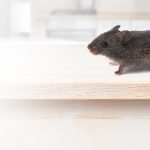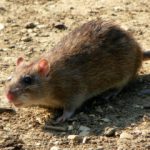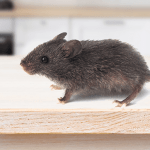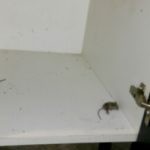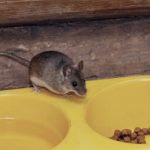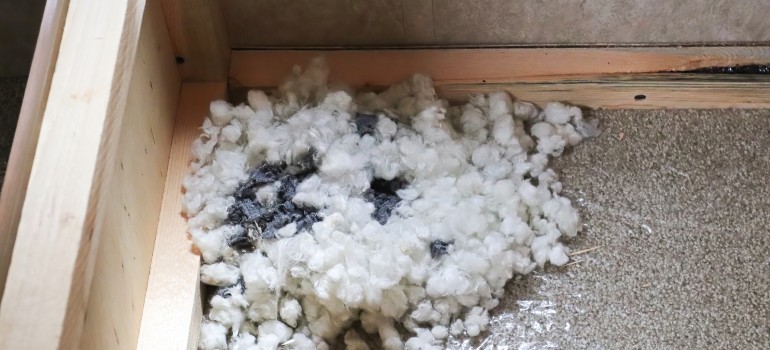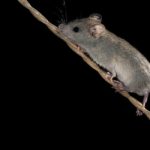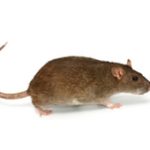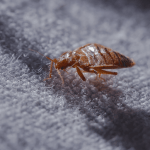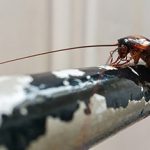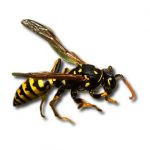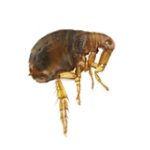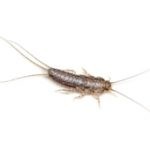Types of Mice in the UK
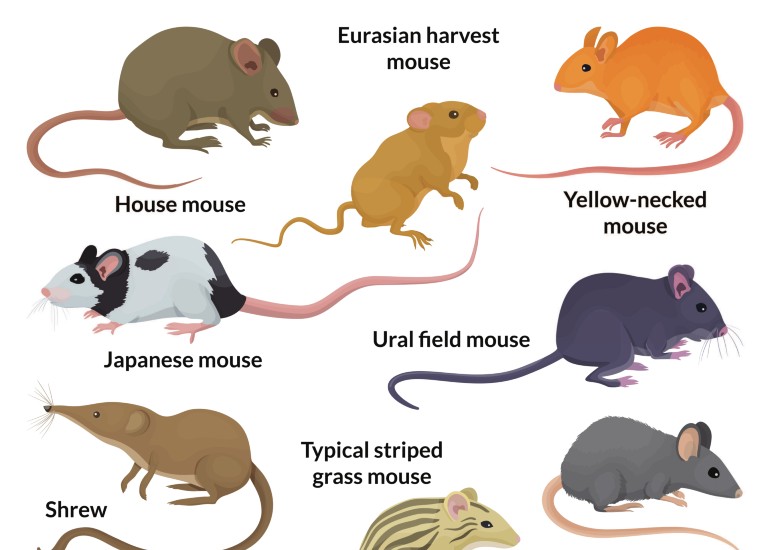
Image: Magicleaf/Shutterstock
Several species of mice live in the UK, but only a few are known to cause infestations in homes. To effectively control rodents, it is important to understand the different types of mice in the UK, their behaviour, and how to identify them.
The three most common mice found in UK homes are the house mouse, field mouse, and yellow-necked mouse. For effective rodent control, it is essential to identify the mice species. A lot of mice nest in gardens before seeking shelter indoors, which is why you can often find them there. As voles and mice have different habitats and behaviors, it is crucial to distinguish between them.
The House Mouse (Mus domesticus)
The house mouse is the most common rodent pest in UK homes. It thrives in human environments, making its way into buildings in search of food and warmth.
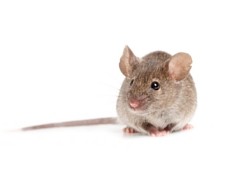
- Size: 7–10cm (excluding tail)
- Colour: Light brown to grey
- Habitat: Indoors, including kitchens, lofts, and wall cavities
- Behaviour: Nocturnal, agile climber, nests in hidden areas
- Diet: Grains, cereals, food scraps, and household waste
The house mouse isn’t a big fan of conditions that involve water but doesn’t have problems with the cold. If you are living on a farm, taking care of wheat crops, you have a higher chance of spotting this creature because of its appetite for grain. An interesting fact is that the mouse will take a jog every day, checking its territory for any new changes.
How does the house mouse affect humans?
If the rodent is not located vaccinated in a tank in your house, it can pose a serious health threat. Undomesticated pest mice can transmit a number of diseases such as leptospirosis, murine typhus, rickettsialpox, tularemia, lymphocytic choriomeningitis and potentially bubonic plague.
The Yellow-Necked Field Mouse (Apodemus flavicollis)
This mouse species closely resembles the field mouse but has a distinctive yellowish collar. Adorable as it is, the yellow-necked field mouse is not the sort of animal you would want to find in your house. Why you ask? Well, the small creature is a carrier of the Dobrova virus. Here is how the mouse differs from other species in its family:
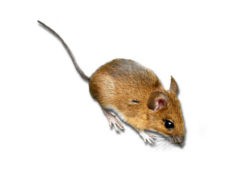
- Size: 9–12cm (excluding tail)
- Colour: Brown with a yellowish chest band
- Habitat: Woodlands, but may enter homes in rural areas
- Behaviour: Agile jumper, known for gnawing wires and insulation
- Diet: Nuts, seeds, fruit, and insects
The yellow-necked mouse habitats gardens, coniferous, and mixed woodlands. It can be found in only a few, restricted areas in the UK: from Dorset across to Kent and Suffolk, and along the Severn basin from Gloucestershire to Staffordshire. The yellow-necked mice nests above ground in tree holes, dormice boxes and in houses, but are more prone to build complicated underground tunnels.
How does the yellow-necked field mouse affect humans?
This representative of the rodent family is known to host the Dobrava virus. The disease can cause hemorrhagic fever with renal syndrome. Needless to say, if you spot a yellow-necked field mouse in your house, better get rid of it pretty fast.
Field Mouse (Apodemus sylvaticus)
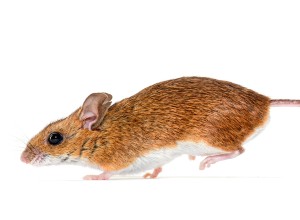
Also known as the wood mouse, this UK species mice is more common in gardens and rural areas but can enter homes during colder months.
- Size: 8–10cm (excluding tail)
- Colour: Reddish-brown with a white underbelly
- Habitat: Gardens, sheds, garages, and occasionally homes
- Behaviour: Excellent digger, fast runner, often found near compost bins
- Diet: Seeds, nuts, insects, and plant matter
Only a few field mice survive from one summer to the next because of the unfriendly behaviour of foxes, weasels, owls and domestic cats. Their litter usually consist of 4-7 young, which are bred from March to October. They can continue making babies in the winter if they have enough food and good living conditions available.
Wood mice can be found mainly in the British Isles. Their home of choice are woodlands and fields but are still are highly adaptable. The wood mouse leaves things such as leaves and twigs in special parts of their territory for navigation. No other mice species is known to have habits such as this.
Again, like the yellow-necked field mouse, this type of mice likes to eat mainly of fruit and plants. They also have a soft spot for acorns, ash, sycamore seeds, fungi and some types of bugs. Field mice tend to hide their bounty in birds nests and underground burrows for the colder months.
How does the field mouse affect humans?
This type of mouse can easily be classified as a pest because of its habit of storming into kitchens to look for something to nibble on. On the other hand, these little critters can actually be of some help, because they are known to eat harmful insects. Still, it’s never a good idea to have any type of mice running around your house, no matter their good intentions.
How Do I Tell What Kind of Mouse I Have?
Identifying the type of mouse in your home is crucial for effective rodent control. Here are some key features to help you identify different types of mice in the UK:
- Size and colour: House mice are smaller and greyish, while field mice are larger with reddish-brown fur.
- Droppings: House mouse droppings are small, dark, and pointed, whereas field mouse droppings are larger and more cylindrical.
- Nesting areas: House mice prefer indoor spaces like lofts and walls, while field mice build nests in sheds and gardens.
- Gnaw marks: Mice leave behind chew marks on wood, wires, and food packaging. House mice tend to gnaw more frequently due to their indoor habitat.
How Are Mice Different Than Rats and Voles?
Voles and mice are often mistaken for one another, but they have distinct differences. Voles have a stockier, more compact body, whereas mice are slender with longer limbs. Mice have long, thin tails nearly the length of their body, while voles have short, furry tails. Mice have pointed snouts, whereas voles have blunt, rounded noses. Also, mice have large, prominent ears and eyes, while voles have smaller, less noticeable features.
Rats are visibly bigger in size than most fancy mice or voles. They also differ in their eating habits as well. While both mice and rats like to feast on a variety of cuisine, the brown rat and fancy mouse are more prone to eat cereal-type of food, while the black rat prefers food higher in moisture content. A voles diet is vegetarian, while rats have predatory instincts. If your beloved garden tomatoes or carrots look chewed upon, you are most probably dealing with a vole.
Learn more about the difference between mice and rats
What Makes Mice Dangerous to Homeowners in the UK?
It’s common knowledge that mice host a huge number of health-threatening diseases. If your property gets infested by the animal you risk getting infected by leftover urine or from any food they got in contact with. Mice can also play a negative role in the safety of your home. They tend to chew on everything they get their little grubby paws on, including electrical cables. A damaged cable can start a fire without you even knowing it. Yup, you read this right. A creature weighing 20 grams can burn down your entire house. Here is a list of more damages the rodent can cause:
- Rodents can chew through your furniture in order to create a nest inside;
- If your insulation is made from a soft material, mice can damage it by making tunnels in it;
- They will go in your food supply, contaminating it with their urine, droppings, and hair;
- In the attempt to get inside your property, they can damage its infrastructure;
- Mice can dig up your garden, bringing an end to all of your plants.
Quite the little renovators, aren’t they?
How to avoid mice infestations?
A good, but unpractical for some people (especially those with allergies) idea is to get a pet cat. It’s self-explanatory – the two animals are natural enemies. Make a point to keep your food in airtight containers, so the mice don’t have access to it. Keep your home as clean as possible. Declutter from any type of old paper such as magazines or piles of newspapers, that can serve as a snack for the creatures. Get rid of old furniture in your basement or attic. Mice have the tendency to make apartment buildings out of dusty sofas. Inspect your home for any types of holes that can act as entry points for the furballs and seal them immediately.
Check our dedicated article on how to get rid of mice
So, if you spot any of the described types of mice, best check for signs of infestation. Eliminate the chances of the situation getting out of hand. We advise you to hire a mouse exterminator to inspect and treat your property. Don’t put your family and homes safety at risk.
Bear in mind that we only aim to provide some useful information about the types of mice in the UK, what are the possible health risks and dangers to you and your family. We cannot guarantee that you will experience the above problems. We don’t provide professional medical advice.



